Traditional Filipino Weaving Techniques
Filipino weaving techniques vary across regions, employing diverse materials and methods.
One common technique in the Cordillera region is the use of backstrap looms, which allow for manual control over the weaving process. In contrast, the Ilocos region primarily utilizes pedal looms, which enable faster production.
Filipino weavers use various materials, including abaca, pineapple fiber, and cotton, to create distinct textiles like piña and t'nalak.
Two essential methods in Filipino weaving are ikat dyeing, which creates intricate patterns by binding and dyeing threads before weaving, and brocade weaving, which produces richly textured fabrics by interweaving different colors and materials.
Regional variations in design motifs are influenced by cultural beliefs and environmental factors. For example, geometric patterns are prevalent in some regions, while nature-inspired patterns are common in others. These patterns reflect the unique cultural identity and environmental context of each region.
Regional Weaving Traditions
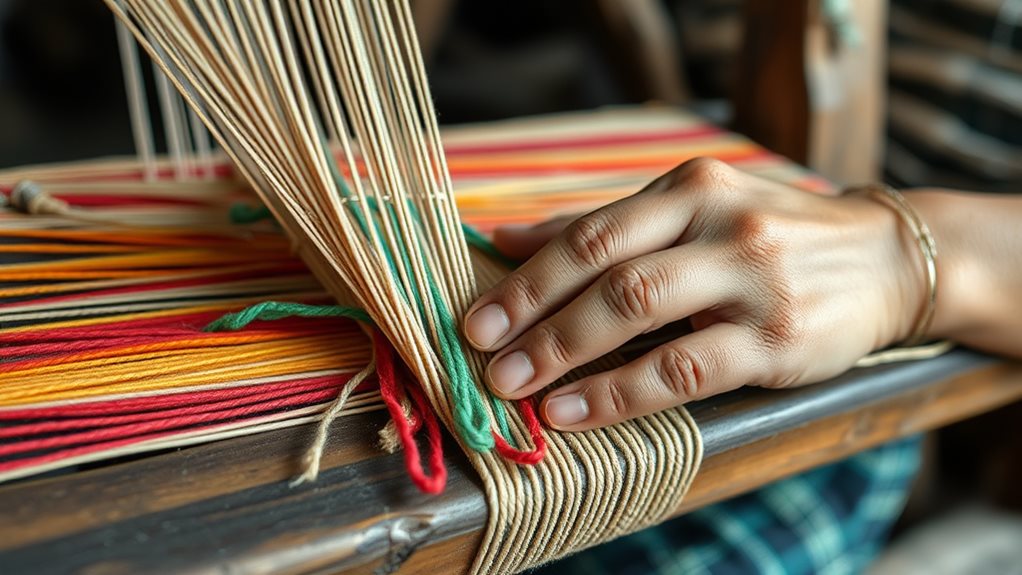
The Philippines boasts a rich tapestry of weaving traditions, varying considerably by region. Ilocano people of the Ilocos Region use pedal looms to create intricate designs like binakul and pinilian. Their weaving techniques are passed down through community involvement, although the symbolism behind them isn't extensively documented.
In the Cordillera Administrative Region, diverse ethnic groups like the Itneg, Ifugao, and others employ both back-strap and pedal looms. The Ifugao showcase their mastery of multi-heddle and pinilian weaving, imbuing their prestige ritual blankets with deep symbolism connected to deities like Punholda'yan.
Bicolano weavers in the Bicol Region utilize suk-suk for figurative designs**, while Mangyan weavers on Mindoro Island create textiles with characteristic warp float patterns. The sinamay tradition of Catanduanes reflects the impact of colonization**.
The Visayas and Mindanao regions are home to a vast array of weaving traditions. The T'boli people's t'nalak, with its rich symbolism representing life's cycle, is a prime example. Community involvement is central to the creation of these textiles, which are integral to their cultural practices.
The Mandaya and Bagobo weave using abaca fiber, reflecting strong regional identities and expertise.
These diverse styles, ranging from simplified geometric designs to complex figurative representations, demonstrate the depth and breadth of Filipino weaving traditions. Each region's unique approach to weaving reflects its cultural identity and the community involvement that sustains these practices.
Key Materials and Fibers
Filipino Weaving Traditions Rely on Diverse Materials and Fibers
Filipino weaving traditions utilize a diverse range of materials and fibers, reflecting regional availability and cultural significance. These materials include abaca, pineapple fibers, cotton, banana, cogon, and maguey fibers. Abaca, a strong fiber from the abaca plant, is used by groups like the T'boli and Bagobo. Pineapple fibers, extracted from pineapple leaves, contribute to the delicate piña textiles of the Visayas. Ilocano weavers use cotton for their Inabel fabrics, often locally sourced.
Extraction and Processing of Fibers Vary
The extraction and processing of these fibers vary. Abaca processing involves stripping, cleaning, drying, and separating fibers. Pineapple fiber extraction is more delicate. Cotton preparation includes harvesting, spinning, and dyeing. Cleaning and drying are essential steps, followed by combing and sorting fibers by thickness before spinning.
Natural Dyes Add Color and Symbolic Meaning
Natural dyes, derived from plants, fruits, and minerals, add color and symbolic meaning to Filipino textiles. Vegetable-based dyes are used in T'nalak fabrics, while Inabel uses a distinct palette. The adoption of chemical dyes has impacted some practices, but weaving innovations continue to explore new possibilities.
Key Materials and Fibers Used in Filipino Weaving
| Fiber Type | Region | Textile Example |
|---|---|---|
| Abaca | Luzon, Visayas | Various fabrics |
| Pineapple Fiber | Visayas | Piña |
| Cotton | Ilocos | Inabel |
Filipino Weaving Traditions Represent a Rich Cultural Heritage
These traditional materials, combined with evolving techniques, represent a rich tapestry of Filipino cultural heritage.
Essential Weaving Techniques
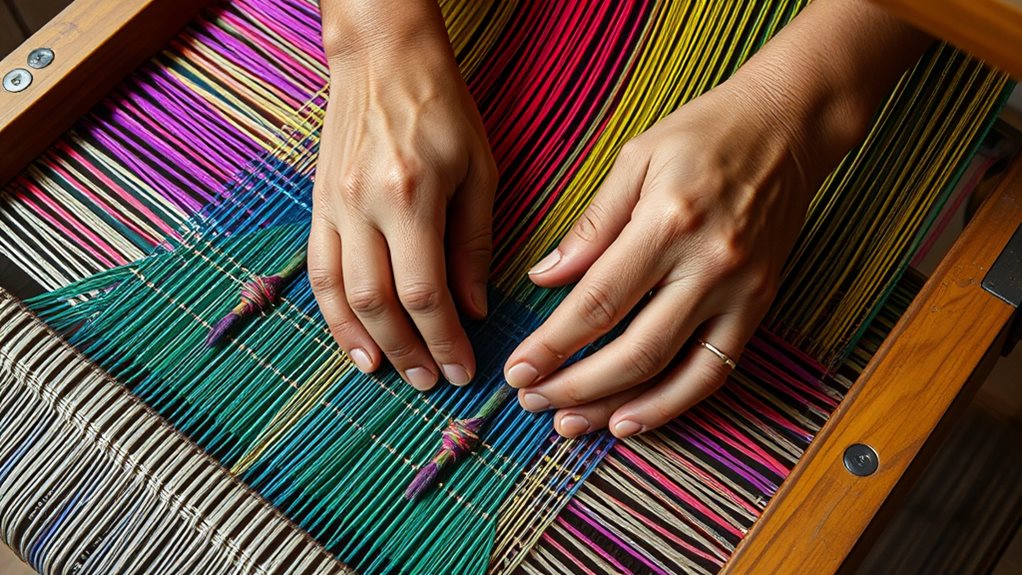
Traditional Weaving Techniques in the Philippines****
The Philippines is home to a diverse array of weaving techniques that reflect regional specialization and innovation. Mastering these techniques requires skill and dedication, as well as the use of specific tools such as the *pinsel* (a wooden beater) and the *lambitin* (a reel for unwinding warp threads).
Regional Specialization and Looms****
Different regions in the Philippines utilize various looms, each with its unique characteristics. The back-strap loom is commonly used in the Cordillera and Mindoro regions, while the pedal loom is more prevalent in Ilocos and Bicol. The *tubod*, a warping frame, is used to prepare warp threads before weaving begins.
Weaving Techniques
Several weaving techniques are used in the Philippines, each with its distinct characteristics. Pinilian is a brocade technique that uses sticks to create floating designs. Ikat is a resist-dyeing method that creates intricate patterns before weaving.
Brocade weaving, which employs supplementary weft threads for detailed motifs, and tapestry weave, such as the Yakan's *saputangan*, are also important techniques.
Back-Strap Loom Techniques
Back-strap loom techniques produce coarsely textured fabrics like the Mandaya's *dagmay*. These techniques involve synchronized hand and foot movements, precise warp and weft preparation, and often the insertion of supplementary weft threads.
Resist-dyeing adds vibrancy and complexity to the fabric.
Key Aspects of Weaving Techniques
- The rhythmic precision involved in operating a loom is essential for producing high-quality fabrics.
- Intricate patterns created using resist-dyeing and supplementary weft threads are a hallmark of traditional Philippine weaving.
- The enduring legacy of traditional weaving practices continues to inspire innovation and adaptation in the industry.
- Ingenious adaptations and weaving innovations across different regions have contributed to the richness and diversity of Philippine weaving.
Common Design and Patterns
Traditional Philippine Textile Designs
Traditional textile designs across the Philippine archipelago reflect a rich tapestry of cultural beliefs, environmental influences, and regional styles. Each region in the Philippines has its own unique design style, often inspired by nature and the environment.
Ilocos Region
The Ilocos region is known for its binakul and pinilian weaves using kapas, which incorporates nature-inspired designs such as flowers, leaves, and celestial bodies within a muted color palette. This design style reflects the region's deep connection with the landscape.
Mindanao Region
In Mindanao, the T'boli people have a rich tradition of ikat weaving, particularly in creating the t'nalak. This style showcases vibrant colors and intricate patterns created through resist-dyeing before weaving. The design symbolism in T'boli textiles is culturally meaningful, often reflecting narratives and beliefs.
Cordillera Region
The Ifugao people in the Cordillera region employ ikat and tie-dye techniques to weave intricate motifs representing their cultural stories and beliefs into prestige ritual blankets and garments. Geometric and nature-inspired elements are prominently featured in their designs.
Visayas and Other Regions
Other regions in the Philippines, such as the Visayas, display diverse techniques in their textile designs. Piña textiles often feature inlaid supplementary weft designs or embroidery.
The Aklanon people are known for their floral designs, while the Yakan people are known for their supplementary weft techniques. The Mandaya dagmay showcases coarsely textured fabrics with designs centered around humanity's relationship with nature.
Regional Variations
These regional styles illustrate the rich diversity and pattern evolution within Philippine weaving traditions, showcasing both design symbolism and the ingenuity of Filipino artisans. Each region's unique design style reflects its own cultural identity and connection to the environment.
Traditional Tools and Implements
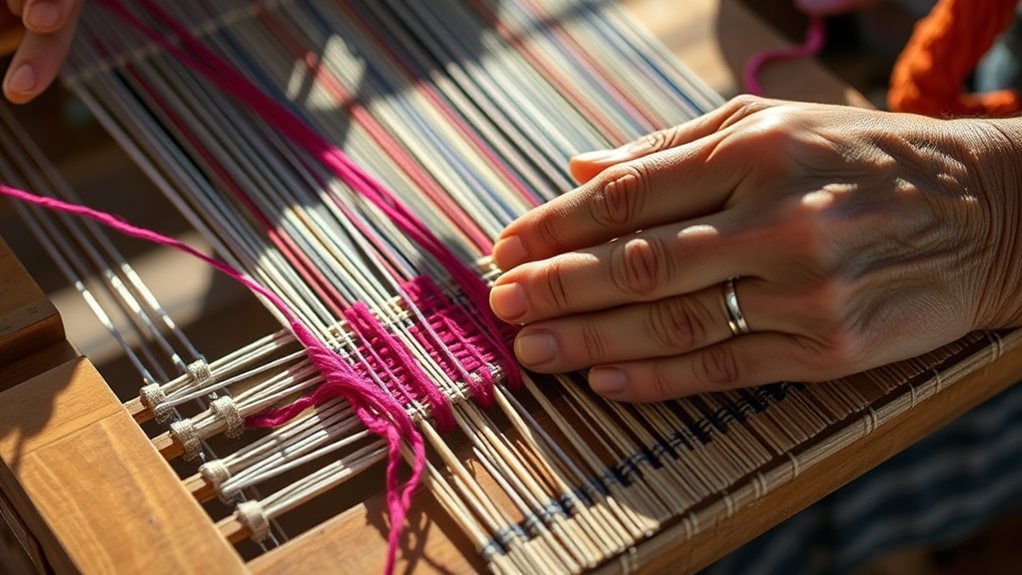
The art of Philippine weaving is deeply rooted in the tools and implements used by weavers. Traditional weaving relies on ingenious tools that have been passed down through generations. These tools are integral to the weaving process, shaping the texture and character of the finished product.
There are various types of looms used in traditional Philippine weaving, each reflecting regional variations. Handloom weaving uses simple bamboo and string structures, while the backstrap loom, prevalent in Luzon and Mindanao, uses a different approach. The Ilocanos' pedal loom, or *pangablan*, is an example of technological innovation. These looms, whether frame or pit looms, maintain warp thread tension, which is vital for interweaving weft threads.
In addition to the loom, weavers use a range of specialized tools. Tapestry needles with wide eyes and blunt edges facilitate the careful insertion of weft threads. The shed stick ensures a smooth, straight weave. Scissors, including embroidery scissors, are used for precise cutting of various materials. Spindle whorls, crafted from stone and baked clay, were fundamental for yarn spinning.
The traditional implements used in Philippine weaving reflect a sophisticated understanding of material properties and craftsmanship. The backstrap loom's portability suited the mobile lifestyle of many communities, while the *pangablan*'s foot-powered mechanism increased weaving efficiency. The use of tapestry needles allowed for intricate detail in woven designs. Spindle whorls represent ancient technology for yarn production.
The careful selection and use of these traditional implements highlight the deep connection between the weaver and the materials. The tools used in Philippine weaving are evidence of sophisticated tool-making skills from ancient times.
Cultural and Historical Significance
Philippine Weaving Holds Deep Cultural and Historical Significance****
Philippine weaving is deeply interwoven with the country's history and identity. Its origins are attributed to deities like Punholda'yan by the Ifugao and Furalo by the B'laan, reflecting a deep-seated spiritual symbolism. Indigenous beliefs consider weaving a bridge between the spiritual and earthly domains, bringing protection and good fortune.
The origins of Philippine weaving date back to the Neolithic era, as confirmed by imprints on clay pots and archaeological findings like spindle whorls** dating back to 2610-2130 BC**. Despite Spanish attempts to suppress indigenous traditions, weaving survived and evolved, showcasing its resilience.
Regional variations in mythology and practice highlight the rich diversity of Philippine ethnolinguistic groups. For example, the T'boli believe the goddess Fu Dalu guides their weaving, highlighting its spiritual connection.
Symbolic designs, often depicting nature, further emphasize this deep connection to the land and its resources. Woven fabrics served as family heirlooms, cherished for their protective qualities. Their ceremonial use in religious and cultural events perpetuated ancestral wisdom and guaranteed the continuation of these traditions.
Designs often symbolize order, balance, and unity within communities, reflecting their social and spiritual significance. The continued practice of weaving across generations maintains its important place within Philippine culture.
Ilocano Weaving Practices
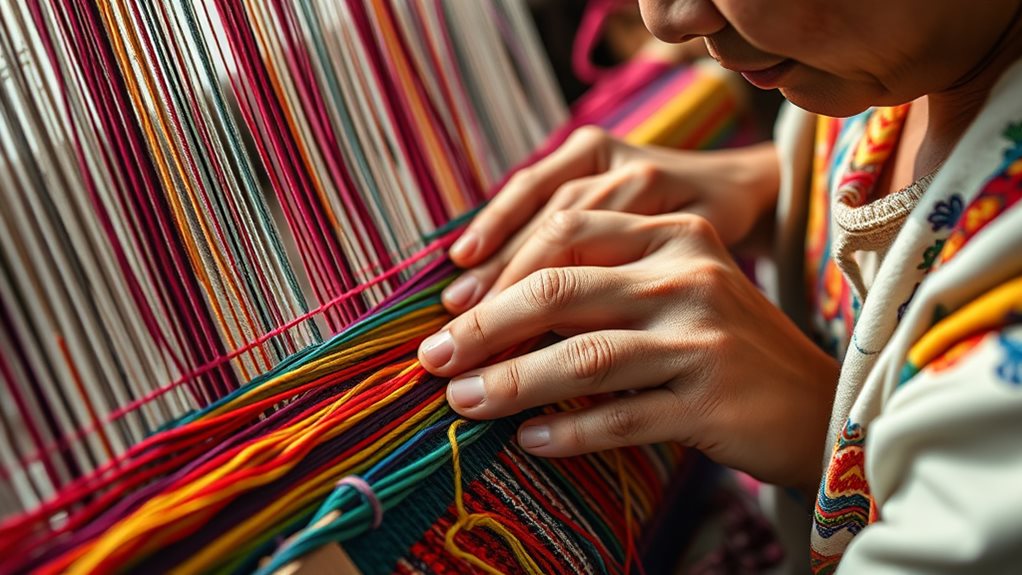
Ilocano Weaving Practices: A Rich Cultural Tradition****
Northern Luzon's Ilocano region boasts a distinct weaving tradition that holds deep cultural importance. Ilocano textiles are created using a hardwood pedal loom called a pangablan.
These textiles are renowned for their intricate designs and exceptional craftsmanship. To prepare the thread, weavers use a wooden spindle called a pulipol. Three main techniques employed in Ilocano weaving are plain weave, double-toned basket weave (binakul), and multi-heddle weave (binetwagan or tinumballitan). The pinilian brocade weave, which uses a heddle bar (sikwan) and the insertion of sticks into warp threads, allows for complex patterns.
Ilocano motifs are deeply symbolic, reflecting the community's connection to nature. Common motifs include geometric patterns like binakol and inuritan, spirals (kusikus), and representations of land formations, flowers, and ocean ripples. Ilocano textiles also feature cat's paws, fans, stars, and windows, while intricate pinilian designs often feature human figures, animals, stars, and eye symbols.
The creation of Ilocano textiles is a labor-intensive process, demanding mathematical precision and meticulous attention to detail. Vibrant colors, achieved through hand-arranged dyes, contribute greatly to the aesthetics of the final product.
Four stages are involved in the process: aggan-ay, agpulipol, agpili, and agabel. These stages highlight the time and skill invested by Ilocano artisans in each piece, often taking days or weeks to complete.
The pinilian technique is notable for its complexity, allowing for designs rarely found elsewhere. The use of nature imagery, such as flowers and ocean ripples, highlights the strong connection between Ilocano weaving and nature. Geometric patterns are prevalent in the textiles, showing a sense of order and simplicity.
The vibrant use of color enhances the overall appeal of individual pieces.
Visayas Piña Textiles
Visayas Piña Textiles
Visayas piña textiles are renowned for their exquisite delicacy and Filipino craftsmanship. The fibers used in these textiles come from the inner leaf layer of the Red Spanish pineapple plant. These fibers are extracted using a porcelain shard and coconut shell, then meticulously cleaned and dried. The finer liniwan fibers are used for hand-knotting****, while the rougher bastos fibers are used for twine.
Piña Production Process
To create piña textiles, the finer fibers are hand-knotted into continuous strands, a process known as pagpanug-ot. These strands are then spooled onto bamboo bobbins and warped for weaving on a foot-operated loom.
Piña fibers can be combined with silk or cotton for added strength. Natural dyes, such as indigo, are also used to lend vibrant colors to the fabric.
Piña Craftsmanship Techniques
Piña craftsmanship involves intricate techniques like ringgue, pili, and tablero weaves. Embellishments such as calado and sombrado, alongside detailed embroidery, are often used to add beauty to the fabric. The resulting piña fabric, sometimes blended with silk to create piña-seda, is used in formal wear.
Cultural Significance and Sustainability****
The tradition of piña textiles is centered in Aklan and Palawan and boasts a history spanning centuries.
Piña's historical significance is undeniable, as it was once favored by both European aristocracy and Filipino elites. The use of natural materials and traditional methods in piña production also suggests a degree of textile sustainability.
Piña's recent inscription on UNESCO's intangible cultural heritage list underscores its enduring value.
Cordillera Weaving Traditions
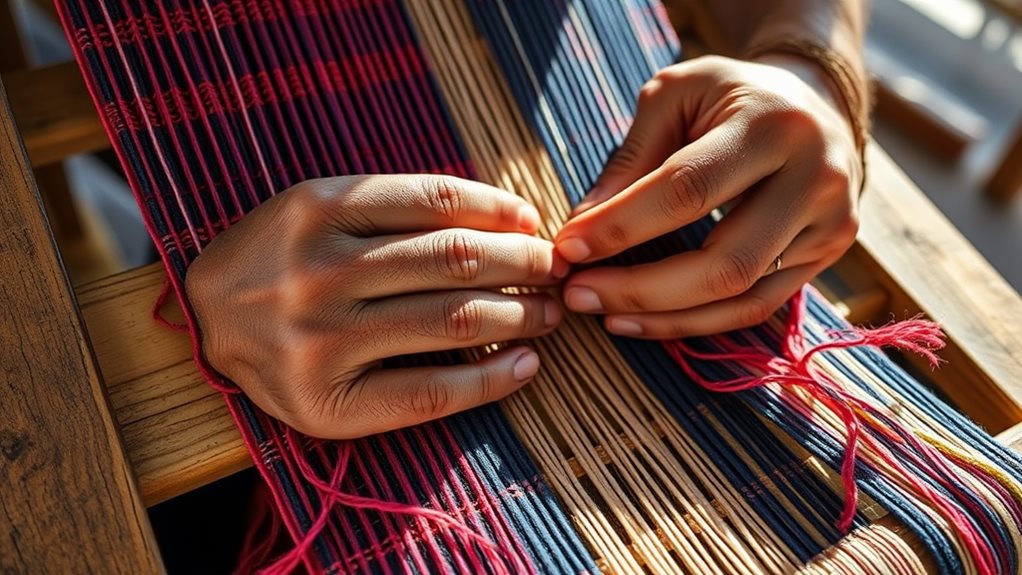
Cordillera Weaving Traditions: A Rich Cultural Heritage
The Cordillera region in northern Luzon, Philippines, is home to a diverse array of weaving techniques practiced by ethnic groups such as the Ifugao, Kalinga, and Bontoc. Each group has unique styles, passed down through generations of community artisans, primarily elderly women.
Weaving Techniques and Materials
The backstrap loom technique is a hallmark of Cordillera weaving, producing textiles with intricate patterns.
This technique involves a simple, portable loom that's secured to the weaver's waist with a strap, allowing for flexibility and control. Additionally, natural dyes from local flora are used, adding another layer of cultural significance. For example, the Ifugao people use the leaves of the indigo plant to create a range of blue hues.
Symbolism and Cultural Significance
The patterns on Cordillera textiles carry symbolic weight, reflecting the worldview of the region's people.
For instance, the Bontoc people use geometric patterns to represent their connection to the land and their ancestors. The textiles aren't just a product of skilled craftsmanship but also a deeply rooted cultural practice woven into their rituals and beliefs.
Preservation and Promotion
Modern efforts, such as weaving workshops, aim to preserve and promote Cordillera weaving traditions.
The Cordillera Textiles Project is one initiative that provides training and support to community artisans, helping to safeguard their knowledge and skills. However, the dwindling number of master weavers threatens this living heritage, making community efforts essential for its survival.
Supporting the Tradition
To participate in preserving Cordillera weaving, one can support community artisans by purchasing their products and participating in initiatives designed to promote their craft.
By doing so, you contribute to the protection of not just the textiles but also the cultural legacy embodied within them. The future of Cordillera weaving depends on the collaborative efforts of all involved.
Bicol Abaca Cloth Production
Abaca Fiber Production in the Bicol Region****
The Bicol region in southeastern Luzon is home to a rich textile tradition centered around abaca, a robust fiber derived from the *Musa textilis* plant. Abaca sustainability begins with harvesting techniques that prioritize the plant's life cycle. Harvesting involves cutting the leaf-stems after flowering but before fruiting, followed by "tuxying," the separation of primary and secondary sheath layers. The outer layer yields primary fibers, while the inner layers contain secondary fibers and pulp.
Fiber Extraction and Processing
Fibers are extracted by hand using a stripping knife, then combed and sun-dried using traditional methods. The fibers are graded according to international standards and bundled together. Washing and drying impart a pale, lustrous appearance, and spinning the fibers into threads can be done manually or mechanized. Lighter-colored fibers are more expensive due to their rarity.
Weaving and Finishing Techniques****
Abaca cloth is created by weaving the fibers on traditional looms or modern steel handlooms, which increase production speed. Pounding the fibers produces finer, softer "pinukpok" fabric. Boiling, bleaching, and dyeing enhance the fabric's sheen and texture. Natural dyes add color and symbolic meaning, and techniques like resist, ikat, and overdyeing can be used to create patterns. A beeswax coating can also be applied for waterproofing.
Modern Innovations and Cultural Significance****
Modern innovations have integrated pinukpok into high fashion, showcasing its elegance and cultural heritage while promoting abaca sustainability and the preservation of traditional textile techniques.
Mindanao's Diverse Weaves
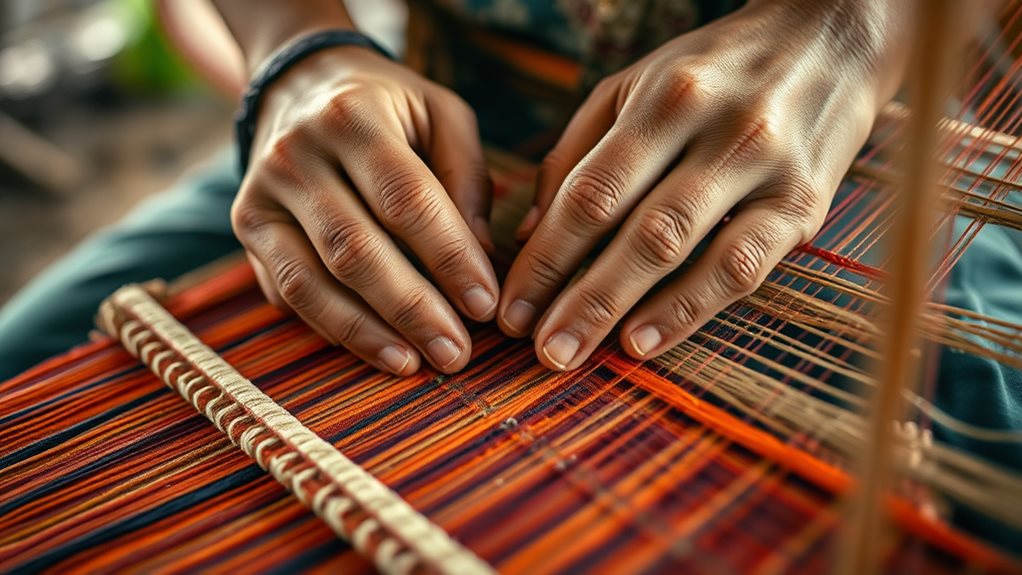
Mindanao's Rich Weaving Traditions
Mindanao, a major island in the southern Philippines, is home to diverse ethnic groups, each with its own unique weaving traditions. These traditions reflect the unique cultural heritage of these groups.
Mindanao's textiles showcase Indigenous craftsmanship across various communities. Traditional patterns, developed over generations, are integral to the identity of these groups. Artisanal techniques, passed down through families, have resulted in breathtakingly intricate designs. Regional influences and cultural exchange between groups have contributed to the diversity of styles across Mindanao.
In Eastern Mindanao, the Mandaya, Bagobo, and Kulaman peoples use abaca and cotton, employing ikat dyeing techniques and back-strap looms to create distinctive textiles. Their designs often feature embroidery and beadwork. For example, the Mandaya use ikat dyeing techniques to create intricate patterns on their textiles.
In South Cotabato, the T'boli and B'laan weave abaca into vibrant cloths using a tri-color scheme, reflecting their unique folklore.
In Western Mindanao, the Maranao and Maguindanao employ silk, cotton, and abaca to produce elegant malongs, often incorporating langkit strips. The Subanen utilize back-strap looms, while the Yakan and Tausug of the Sulu Archipelago continue their rich tapestry and embroidery traditions.
Notable textile examples include:
- The striking tri-color schemes of the T'boli and B'laan textiles
- The intricate tapestry weaves and multi-heddle techniques of the Yakan
- The magnificent malongs of the Maguindanao and Maranao people
- The use of natural dyes and abaca fibers in Eastern Mindanao
These weaving communities' shared skills and diverse aesthetics illustrate the remarkable depth and complexity of textile symbolism within Mindanao's rich cultural landscape.
Weaving techniques, materials, and patterns represent not just utilitarian objects, but also powerful statements of cultural identity, history, and beliefs.
Mindoro Mangyan Textiles
Mindoro Mangyan Textiles' Unique Weaving Process****
The weaving process of Mindoro's Mangyan communities involves using a backstrap loom, known as a "habilan," which is often attached to a house wall or tree. This traditional loom allows weavers to meticulously align threads between bamboo sticks, creating the textile's foundation, referred to as "han-ay" and "habihin."
This painstaking work can last up to a month, resulting in intricate textiles with geometric patterns.
Materials Used in Ramit Textiles****
Ramit textiles' materials are carefully sourced. Traditional materials include indigenous cotton, while modern Ramit weaving incorporates cotton from industrial sources.
In addition to cotton, Ramit textiles may also be made from recycled commercial threads. Indigo dye is used to create distinctive blue hues. Gathering and processing these materials often takes days, and in the past, other crafts used Buri leaves and nito vine strips.
Cultural Significance of Ramit Textiles
Ramit textiles hold significant cultural importance for the Mangyan communities. They are a vital source of livelihood and central to Mangyan identity.
Women wear Ramit skirts, known as "balukas," and men wear loincloths, referred to as "ba-ag." The intricate patterns, such as "pakudos," symbolize tribal affiliation. These textiles also serve practical purposes, including carrying babies. Each of Mindoro's eight Mangyan tribes possesses a unique weaving style, reflecting their distinct artistic expression.
Preserving Ramit Textiles' Tradition
The preservation of Ramit textiles relies on sustainable practices, partnerships, and education. Efforts by the Hanunuo and Buhid tribes to manage and design these textiles are crucial in maintaining this tradition.
The Art of Ikat Dyeing
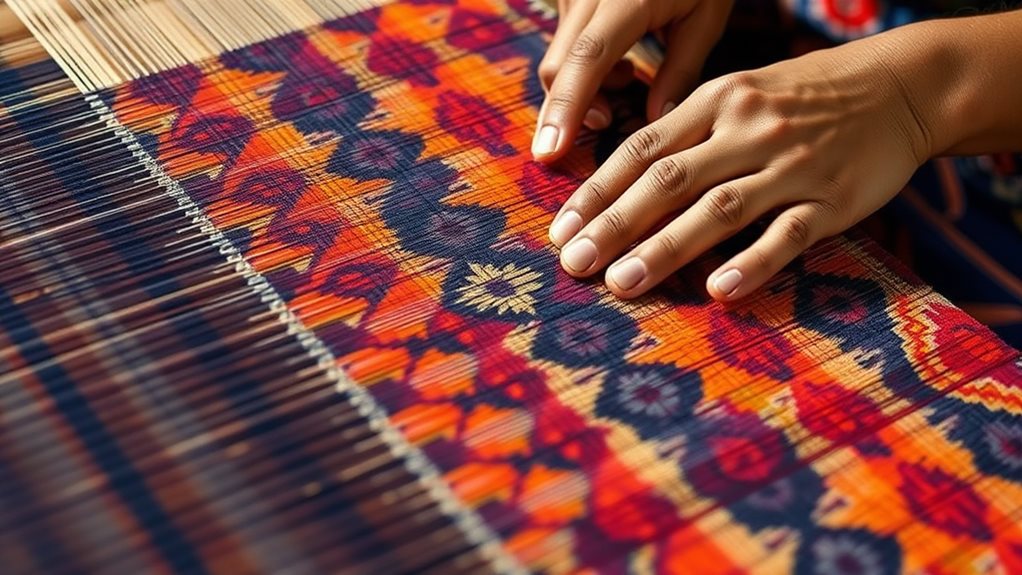
Ikat dyeing involves meticulously dyeing yarns before weaving to create intricate patterns. This pre-weaving dyeing process is essential to achieving the desired designs and colors in the finished textile. To create these patterns, different binding methods such as knotting or wrapping are employed to resist the dye. As a result, the characteristic ikat patterns are formed.
The dyeing techniques used in ikat dyeing vary regionally, with unique approaches adopted by different communities. For example, the T'boli of Mindanao and the Ifugao of Luzon**** utilize distinct methods to create their traditional textiles. These regional variations add to the rich tapestry of Filipino textile traditions.
Ikat symbolism is deeply embedded in these textiles, with colors and patterns often carrying important meanings related to nature, spirituality, and cultural identity. Understanding the dyeing process is also essential to appreciating the artistry involved in creating these textiles.
Natural dyes are used to create vibrant colors in ikat textiles. For instance, the colors derived from these natural dyes reflect the ingenuity of Filipino weavers. The binding techniques used to produce distinctive patterns are also intricate. Knotting and wrapping are examples of these techniques.
The tools used in ikat dyeing are equally fascinating. Depending on the community, backstrap looms or pedal looms**** may be used alongside specialized tools for tying and dyeing. These traditional methods are integral to the creation of unique textiles.
Each community's unique methods contribute to the diverse landscape of Filipino ikat textiles.
Filipino ikat textiles are repositories of history, tradition, and cultural narratives. They aren't merely cloth but represent the stories and beliefs of the communities that create them.
Preserving Weaving Heritage
Preserving the Rich Heritage of Filipino Weaving
Preserving the vibrant tapestry of Filipino weaving traditions requires a multi-faceted approach. This approach includes the preservation of traditional techniques, recognition of cultural significance, and provision of economic and social support.
Traditional Techniques and Materials
Filipino weaving relies on the use of natural materials like abaca, cotton, piña, and silk. Traditional looms and intricate designs are also essential for maintaining this cultural heritage.
Techniques such as pinilian, binakul, and ikat must be transmitted from older to younger generations to ensure their survival.
Natural dyes are crucial for continued cultural expression through textile art, as they carry rich symbolic meanings.
Cultural Significance and Community Involvement****
Weaving is fundamental to Filipino cultural identity, reflecting worldviews and belief systems. Each woven piece tells a story, carrying symbolic meanings tied to nature and local traditions.
Community involvement in weaving strengthens social bonds, and its use in rituals and ceremonies further enhances its significance. This highlights the importance of cultural revitalization through the support of this indispensable practice.
Economic and Social Support
Weaving provides economic sustenance for many communities, with local and international markets creating demand and generating income.
It empowers women and creates jobs, bolstering local economies. Cultural tourism, driven by the allure of traditional weaving, further contributes to its preservation.
Supporting initiatives like educational programs, documentation efforts, and historical research is crucial for a deeper understanding and appreciation of this rich heritage.
Questions and Answers
What's the Average Weaving Time for a Textile?
The average weaving time for a textile varies greatly depending on several factors. The time can range from a few days for simple textiles to several weeks for intricate ones.
The complexity of weaving patterns is a significant factor in determining the weaving time. For example, a simple scarf with a repeating pattern can be woven quickly, while a complex piece of fabric with multiple colors and patterns can take much longer to complete.
The type of loom used also affects the weaving time. Hand looms typically take longer than power looms, as they require manual effort to weave each thread. However, hand looms can produce more intricate and unique patterns, which may be desirable for certain types of textiles.
The preparation of the fiber is another factor that influences weaving time. Fibers that require extensive preparation, such as wool or silk, can increase the overall weaving time. Conversely, fibers that are easy to prepare, such as cotton, can speed up the weaving process.
How Much Do Filipino Textiles Typically Cost?
Filipino textiles vary widely in price.
The prices of simpler pieces can be relatively affordable, while intricate ones can be expensive. For example, a simple 'malong' textile, a traditional Filipino garment, may cost between $10 to $30. On the other hand, an intricate 't'nalak' textile, a sacred fabric woven by the T'boli tribe of South Cotabato, can cost $100 to $500 or more, depending on the complexity of the design and the expertise of the weaver.
Materials and labor are key factors in determining the cost. Textiles made from high-quality materials, such as silk or cotton, and those that require more time and skill to create can be more expensive. For instance, a 'piña' textile, made from pineapple fibers, can be $50 to $200 or more, due to the time-consuming process of extracting and weaving the fibers.
Cultural significance also plays a role in pricing. Textiles with cultural or historical significance, such as those used in traditional ceremonies or rituals, can be more valuable and expensive. For example, a vintage 't'nalak' textile can be $1,000 to $5,000 or more, depending on its rarity and cultural importance.
Where Can I Buy Authentic Filipino Textiles?
Authentic Filipino textiles can be found through various channels. Online marketplaces like Anthill Fabrics and Malingkat Weaves offer a diverse range of handwoven materials and unique designs. In addition to these platforms, you can also purchase textiles directly from local artisans, supporting the local community and ensuring the product's authenticity.
Are There Weaving Apprenticeships Available?
Weaving apprenticeships are not formally structured, but they exist within weaving communities.
These apprenticeships focus on hands-on learning, which allows individuals to develop skills by working directly with experienced weavers. This type of learning preserves the history and cultural significance of weaving traditions. For example, a weaving apprentice might learn from a master weaver in a Native American community, where they would learn specific techniques and patterns that have been passed down through generations. By working closely with experienced weavers, apprentices gain a deeper understanding of the cultural and historical context of weaving, while also developing their own skills.
How Is Textile Sustainability Ensured?
Textile sustainability is ensured through three key methods: using eco-friendly materials, supporting artisans, and preserving cultural heritage.
Eco-friendly materials play a crucial role in minimizing the environmental impact of the textile industry. Natural fibers such as organic cotton, hemp, and bamboo reduce the need for pesticides, synthetic fertilizers, and excessive water usage. Additionally, natural dyes derived from plants and minerals – like indigo, turmeric, and pomegranate – offer an alternative to synthetic dyes that pollute waterways.
Supporting artisans and preserving cultural heritage are also essential components of textile sustainability. Artisans use traditional techniques and local materials, helping to preserve cultural practices and promote community development. By supporting these artisans, textile companies can ensure that their products have a positive social and environmental impact. Cultural preservation also involves promoting and respecting traditional textile-making techniques, such as hand-weaving and embroidery, which help to maintain cultural identity and promote cultural diversity.